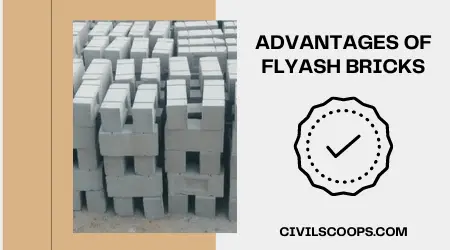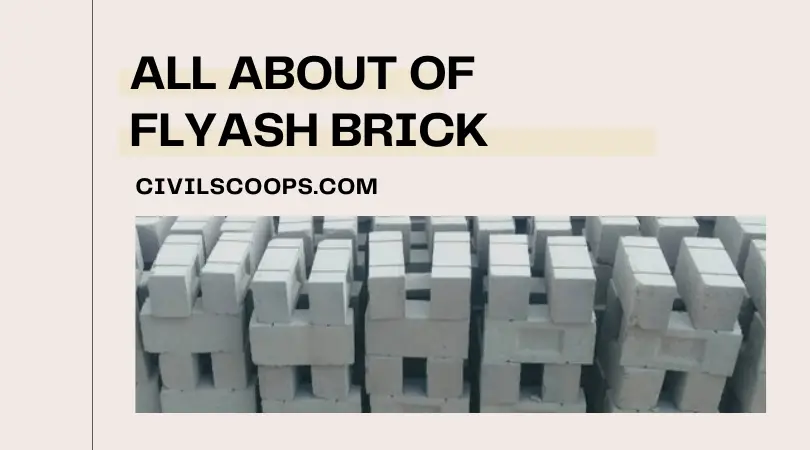Table of Contents
What Is Flyash Brick?
The ash created during coal combustion is known as fly ash. It’s a crystalline dust made from coal power mineral content, which is made up of non-combustible matter and a small volume of carbon left over from combustion products.
These are cured for at least 14 days before being completely dry for 7 days. The formulations of such bricks could be varied to increase their strength. Related to popular burnt clay bricks, this is being used in a variety of building construction practises. Fly ash bricks are light weight and heavier than traditional clay bricks.
- High compressive strength is one of the advantages.
- Water absorption is poor.
- Uniform shape ensures dimensional precision.
- High weight-to-strength ratio.
- During the manufacturing process, no greenhouse gases are released.
- There is no efflorescence.
- In architecture, use less mortar.
Also Read: Density of Cement Sand and Aggregate | Density of Cement | Density of Sand | Density of Aggregate
Fly Ash Bricks Cost
The price of fly ash bricks varies depending on the composition. However, whichever fly ash bricks mixing ratio is used, the consistency must be maintained as well.
The cost of fly ash bricks is comparable to that of regular fire clay bricks. The cost of fly ash bricks is determined by the following factors:
- The price of raw materials
- The amount of raw material used
- The degree of automation
- Adoption of technology
- Finance costs
- Size economies
So, above those points, the price of fly ash bricks ranges from 8-10 rupees per piece, while the price of standard fire clay bricks is about 11-12 rupees per piece.
Properties of Flyash Bricks
- The bricks have an appealing cement colour that is uniform in hue and smooth, so they do not need to be plastered for construction projects.
- They don’t absorb heat and reflect the most light.
- It has a satisfactory level of sound insulation.
- They have excellent fire resistance and are unaffected by vermin attacks.
- These blocks are very durable, absorbing 6–12% of water and lowering the humidity of the walls.
- Fly ash becomes a non-toxic substance when combined with lime, making it a suitable construction medium.
Fly Ash Bricks Manufacturing Process
Mix Proportion:
- Fly ash = 70%
- lime = 10%
- gypsum = 5%
- sand = 15%.
Process :
- These raw resources are personally fed into a panmixer, whereby water is applied in the necessary ratio for homogeneous mixing.
- Based on the nature of the raw resources, the ratio of raw resources can change.
- Upon combining, the mixture is fed via a belt conveyor into an automated brick making system, where the bricks are mechanically pressed.
- The bricks are then put on wooden pallets and left for two days before being shipped to the an open field to be water curing for 10 to 15 days.
- Until being shipped, the bricks are processed and checked.
Also Read: How to Building Construction Process Step by Step
Compressive Strength of Fly Ash Brick
- Flyash bricks have three times the compressive strength of regular clay bricks.
- Clay brick has a minimum compressive power of 3.5 N/mm2.
- As a result, the compressive pressure of the flyash brick is 10-12 N/mm2.
- Compressive strength of bricks used for various purposes should not be less than that mentioned above.
- For measuring the compressive strength of bricks, the universal testing unit is used. Bricks are held for testing until the curing process has ended.
- To measure the specimens, the bricks are loaded uniformly at a rate of 2.9 kN/min into a calibrated Compression measuring system with a capacity of 3000 kN.
- The full load at which the specimen fails to achieve any further improvement in the indicator reading on the measuring system is known as the load at failure.
- For each mix percentage, three numbers of bricks were checked.
- Each brick can have a different level of strength. As a result, a three-brick average was used.
Also Read: Building Layout | How to Building Layout | Construction Layout Techniques
Fly Ash Brick Size
- rectangular solid fly ash brick, medium and light weight used in building, with a minimum, ordinary, natural size of 230 mm x 110 mm x 75 mm or 9′′ x 4′′ x 3′′ in inch and a maximum size of 230 mm x 110 mm x 100 mm in mm or 9′′ x 4′′ x 4′′ in inch.
- For house building, this is the optimal, finest, fine, nominal, and regular size of fly ash brick. In addition, depending on consistency and market preference, it could be available in other appropriate sizes.
- Fly ash bricks are widely found in India, the United States, the United Kingdom, and the Philippines, and are measured in millimetres or inches. Following are the countries of Australia, Canada, Ireland, New Zealand, and other parts of the world.
- 400 mm × 200 mm × 200 mm or 16″ × 8″ × 8″
- 400 mm × 150 mm × 200 mm or 16″ × 6″ × 8″
- 400 mm × 100 mm × 200 mm or 16″ × 4″ × 8″
- 300 mm × 150 mm × 150 mm or 12″ × 6″ × 6″
- 300 mm × 230 mm × 150 mm or 12″ × 9″ × 6″
- 230 mm × 110 mm × 75 mm or 9″ × 4″ × 3″
- 230 mm × 110 mm × 100 mm or 9″ × 4″ × 4″
Fly Ash Block Size
- The larger version of the fly ash brick is the fly ash stone. It is made of the same substance and is prepared using the same process.
- Fly ash bricks are 24in x 8in x 4in dimension.
- These blocks are mostly used in the partition and sidewall walls.
- In India, a single piece of fly ash block costs around 50 rupees.
Advantages of Fly Ash Bricks

- Fly ash bricks are now often used in building and are gaining popularity among builders and engineers due to their high strength, uniformity, and low mortar use.
- Fly ash bricks are lighter than clay bricks, making them ideal for multi-story buildings. Less weight means less tension on the structure, ensuring stability.
- It is an established fact that BIS-certified fly ash bricks are 100 percent more durable and long-lasting than regular red clay bricks or any other traditional construction material.
- Fly ash is both cost-effective and environmentally sustainable.
- During the manufacturing process, no greenhouse gases are released.
- The needed operating area is significantly less than that of any other brick-making unit.
- The use of fly ash in concrete results in a denser blend and a cleaner base.
- Fly ash is the waste left over by coal combustion, and it is produced when the coal’s gaseous emissions are effectively cooled.
- It resembles a fine glass powder in fact. However, the chemical composition of this residue can differ from that of other residues.
- Fly ash is used in a variety of industries and is commonly used in power plant chimneys. By combining the substance with lime and water, it can also be used as a cement substitute.
- The material has a variety of advantageous properties and is thus used as a major building material for construction purposes. This concrete is very dense and smooth.
- Fly ash bricks have a high compressive strength, which is one of the key benefits of using them.
- Its thermal insulation is superior to red clay bricks.
- Fly ash bricks are less expensive than clay bricks and are environmentally safe.
- Through blending effectively with the concrete mix, fly ash will replace Portland cement, resulting in significant cost savings in concrete materials.
- Increased density, as well as the long-term reinforcing action of flash, binds with the free lime and thereby reduces bleed channels and permeability.
- The use of fly ash reduces the permeability of concrete, which helps to keep aggressive composites on the soil, where their damaging effects are minimised.
- It also has a high resistance to mild acids, water, and sulphate.
- It successfully mixes with alkalis found in cement, preventing disruptive expansion.
- It also aids in the reduction of hydration heat.
- Thermal cracking is prevented by the pozzolanic reaction between lime and fly ash, which generates considerably less heat.
- It’s a strategy that really is great for the climate.
- It binds salts and free lime, which can cause efflorescence, chemically and efficiently.
- Fly ash concrete’s lower permeability effectively reduces the impact of efflorescence.
- It gains resilience over time, providing more stability to the structure.
Disadvantages of Fly Ash Bricks

- Poor content frequently has a detrimental effect on concrete, increasing permeability and thereby causing damage to the structure.
- When most fly ash bricks made at a power station are normally ideal for concrete, it’s critical to just use greater fly ash to avoid damaging the building’s foundation.
- Mechanical bonding has a low strength, although this can be improved by using marble waste.
- Throughout the size scale, there will be even more wear and tear.
[note note_color=”#F2F2F2 ” text_color=”#333333″ radius=”3″ class=”” id=””]
Like this post? Share it with your friends!
Suggested Read –
- What Is Estimate? | Types of Estimate | Advantage of Estimate | Disadvantage of Estimate
- What Is Epoxy? | What Is Epoxy Flooring? | Types of Epoxy Flooring | Advantages of Epoxy Flooring | Disadvantages of Epoxy Flooring | Uses of Epoxy Flooring | Application Process of Epoxy Flooring
- Difference Between Short Column and Long Column
- What Is Plastering | What Is Pointing | Difference Between Plastering and Pointing |
- What Is Timber ? | What Is Lumber ? | What Is Lumber Used for ? | Lumber Vs Wood | Difference Between Lumber and Timber | Standard Wood Size | What Is Timber Used for ?
